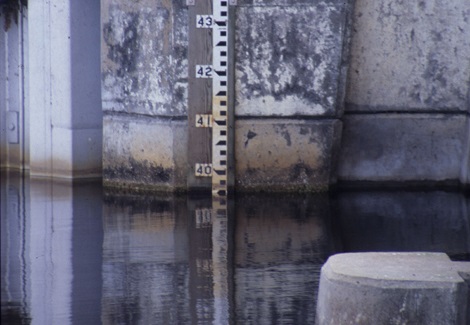Water Level Manipulation
Dewatering / Drawdown
Reduces water level to control exposed plants and improve substrate to support plant diversity
Considerations:
- Must have control structure to lower water level
- Federal, state, local permits may be required
- May require temporary variance from established federal and state water level regulations
- Need reasonable assurance that water body can be refilled after drawdown is complete
- Oxidizes and compacts sediments, creating more suitable native plant habitat
- Best to draw down in winter
- Summer rains and humidity reduce ability to draw down water body and desiccate plants
- Kills target plants through desiccation, freezing and perhaps prescribed fire
- Summer drawdowns may expand nuisance native plants into deeper areas of the water body
- Winter drawdowns may interfere with fish and wildlife habitat utilization and reproduction
- Waterfowl utilization most abundant during winter
- Fish spawn late winter / spring – may impact year class
- Endangered species may lose habitat and forage
- Snail kites nest in winter/spring – low water exposes nests to predation
- Apple snails need water in winter/spring for reproduction
- Most appropriate for controlling overgrowths of native plants
- Hydrilla resists drawdowns via underground turions (tubers)
- Drawdown may allow hydrilla to colonize deeper water – persisting after re-flood
- Desiccation assists water hyacinth seed germination upon re-flood
- May need successive annual drawdowns to control hydrilla and water hyacinth
- Torpedograss is tolerant to wet and dry soils and water depths up to 5-6 feet
- Difficult to get public support
- Loss of recreation (boating, skiing) or associated businesses (fish camp) for several months
- May result in property damage – collapsing seawalls
- May reduce water supply for adjacent agriculture/aquaculture, power generation, drinking water, etc.
- May add too much water to receiving areas like estuaries, already flooded areas, etc.
- Non-selective and will control most plants and animals in the dewatered zone
- May stimulate dense stands of transitional native plants i.e. pickerelweed or smartweed upon re-flood
- May trigger floating rafts of terrestrial plants that grew on exposed bottom, or buoyant sediments such as peat upon re-flood
Examples of Feasible Control:
- Winter drawdowns conducted every three years on Rodman Reservoir control hundreds of acres of water lettuce in areas inaccessible to harvesters and herbicide application equipment
- Winter drawdowns with prescribed fire reduce torpedograss density on Lake Okeechobee
- Winter drawdowns and disking soils enhance maidencane growth on Orange Lake
- Drawdowns and associated sediment removal in the Kissimmee Chain of Lakes offset sediment accumulation accelerated by stabilized water levels, creating more suitable emergent plant habitat
Dewatering / Lower Water Level
Reduces amount of water to be treated with herbicides or applies additional stress to plants
Considerations: Similar to Drydowns
- Reduce water volume by several inches to several feet to facilitate herbicide control
- Reduces amount of herbicide necessary to achieve appropriate concentration
- Creates storage to buffer against rainfall events that could flush herbicides out of the system
- Retains treated water to prevent possible downstream impacts i.e. irrigated crops, fishery, etc.
- Reduces cost of herbicide control
Examples of Feasible Control:
- Lower water level on Lake Istokpoga prior to large-scale hydrilla herbicide control to prevent discharging treated water that may injure downstream irrigated crops
- Reducing water volume in the Kissimmee Chain of Lakes reduces herbicide use by as much as 25% and saves millions of dollars
Flooding / Increase Water Level
Increases water level to control plants below or flushes them out of system
Considerations:
- Need flood control structure
- Ensure that increasing water levels will not flood surrounding structures or developed property
- Flush floating plants (i.e. water hyacinth, tussocks, or floating islands) out of system or into uplands
- Reduce water level quickly to strand floating plants in upland portion of water body
- Reduce light penetration to stress submersed plants after herbicide application
- Flood controlled emergent plants to slow recovery after herbicide application or prescribed fire
Examples of Feasible Control:
- Increasing water level after hydrilla is stressed from herbicide application in Lake Istokpoga reduces light penetration, further stressing treated hydrilla as well as sprouting tubers and turions
- Re-flooding exposed marsh in Lake Okeechobee after herbicide application or prescribed fire slows torpedograss recovery and promotes germination of native plant seed bank
- Pulsing water level increase prior to a winter drawdown on Rodman Reservoir strands hundreds of acres of water lettuce in the uplands exposing them to desiccation and freezing


